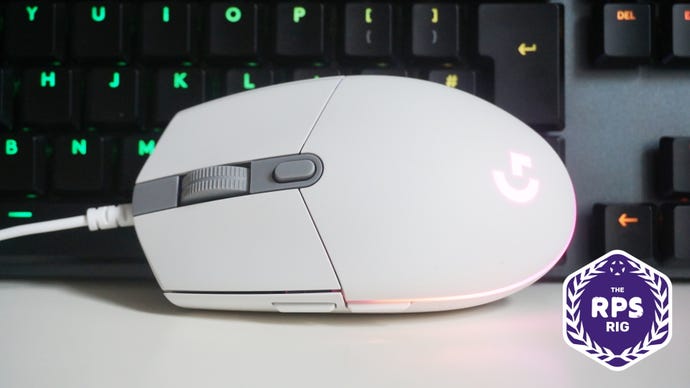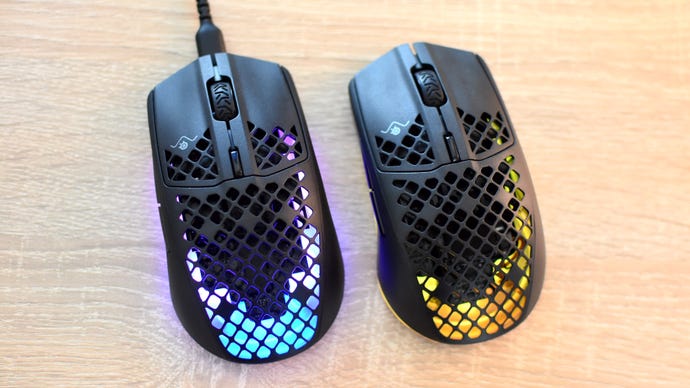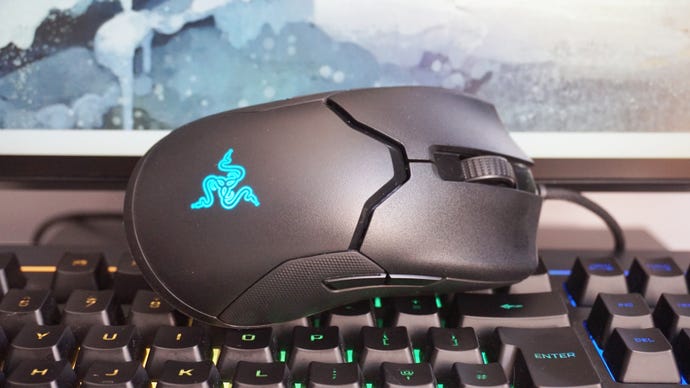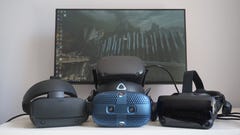Best gaming mouse 2023: the top wired and wireless gaming mice
Our tried and tested gaming mouse picks
Finding the best gaming mouse for your personal grip/button/connectivity requirements used to be a very different process. Not to come over all Luddite in my own co-authored post about consumer electronics, but wasn’t it nice to go into a brick 'n' mortar shop and try each peripheral for yourself? To really get a sense of the weight, the click action, how they felt in the hand? Oh, how much happier humanity would surely be, if it had access to a similar sample platter every time it fancied a new mouse or gaming keyboard.
Hopefully you’ll find this list a workable substitute. It’s a guide to all the best gaming mice – wired and wireless, cheap and premium – that we’ve tested. Thoroughly! By playing actual games with them. Even if it can’t slap a "Try me" sticker on each mouse and offer them directly to your hands, it should help guide you towards the gaming rodents that will best suit your preferences.
Why go for a gaming mouse in the first place, when (possibly more affordable) office mice can swing a cursor around without any brash 'gAm3rrr' branding? Honestly, any mouse is fine for the average point-and-click or puzzle game, though gaming mice often add some genuinely practical, some might even say sensible features. These can range from a wider array of rebindable buttons (especially handy for MMOs) to ergonomic upgrades, like widened thumb rests. And I know that RPS readers aren’t always madly in love with RGB lighting, but hey, you can always switch it off.
In any case, this guide aims to please a range of tastes. And, indeed, hand sizes. The other good news is that if one of our best gaming mouse picks is right for you, there’ll be no need to upgrade again for absolutely ages; mice are, like good keyboards or the best gaming headsets, among the most timeless PC hardware upgrades you can make. Just look at the reader favourite Logitech G502, which has sat atop this list for bloomin' years.
Best gaming mouse
- Logitech G502 - the best gaming mouse overall
- Razer Basilisk V3 Pro - the best premium gaming mouse
- Logitech G203 - the best cheap gaming mouse
- Logitech G Pro Wireless - the best wireless gaming mouse
- Endgame Gear XM2WE - the best lightweight wireless gaming mouse
- Corsair Harpoon RGB Wireless - the best cheap wireless gaming mouse
- HyperX Pulsefire Haste 2 - the best lightweight gaming mouse
- Corsair Ironclaw RGB - the best gaming mouse for big hands
- SteelSeries Aerox 3 / SteelSeries Aerox 3 Wireless - the best gaming mouse for small hands
- Roccat Kone XP Air - the best MMO gaming mouse
- Razer Viper - the best ambidextrous gaming mouse
- AOC Agon AGM600 - best RGB gaming mouse
Logitech G502 Hero
The best gaming mouse overall

Back in the Before Times of 2019, RPS readers voted the Logitech G502 as your favourite gaming mouse. Good choice - I use one regularly as part of the main RPS test rig. There’s just something so wonderfully complete about it: a sweet blend of comfort, features and tactility, with plenty of opportunities for customisation.
That extends from the removeable weights, which you can swap in and out to adjust how the G502 feels, to the support for multiple sensitivity/input/RGB lighting profiles. Speaking of which, the 11 programmable buttons and close to perfectly placed, ready to be pressed without straining a thumb but not intruding into normal digit-resting space. There’s even a satisfying robustness to their clicking action that you don’t always get elsewhere, even on Razer or SteelSeries’ best mice.
The slight hitch is that the original Proteus Spectrum model only seems available at bizarrely inflated prices. Luckily, you can get the newer G502 Hero – which is basically identical, save for an updated, more sensitive sensor – for much more reasonable money.
Read more in our Logitech G502 Hero review
Razer Basilisk V3 Pro
The best premium gaming mouse
I’m almost loathe to replace the Razer Basilisk V3 in this corner of the list, but look, the Razer Basilisk V3 Pro is more or less the same mouse – just with wireless connectivity, a more sensitive optical sensor, and optional wireless charging support. This cutting of the cable doesn’t appear to have done performance any real harm, so even when I’m not on peripheral testing duty, it’s been the gaming mouse I’ve reached for – while the wired Basilisk V3 returns to the kit cupboard.
The Basilisk V3 Pro is a lot pricier than its wired counterpart, not to mention heavier, and if you want its wireless charger – the Razer Mouse Dock Pro – then that’s another big expense. Frankly, it’s a nice but unnecessary luxury, and at least with boring old cabled charging, you can keep using the mouse at the same time. And what a mouse this is: keenly sculpted to fit both palm and fingertip grips, with slip-proof textured rubber sections, tonnes of customisable buttons, solid-feeling optical switches, and a precise scroll wheel. This wheel also has a free-spinning mode, one of the Basilisk’s many similarities with the Logitech G502 series.
Logitech G203
The best cheap gaming mouse

There are loads of budget gaming mice to choose from these days, but the Logitech G203 Lightsync is by far the best of the bunch. Its build quality is much better than its similarly priced rivals, such as the HyperX Pulsefire Core and Steelseries Rival 110, and it also has a more responsive sensor, too.
It's reasonably small, but it's also exceedingly light, making it feel lovely and smooth to move round your mouse mat. Nothing against larger mice, naturally, but they can be more of a chore to move quickly if you have small hands.
The G203 also has two extra side-buttons on the left hand side of the mouse, which can be programmed to do all sorts of diffferent functions. These include keyboard buttons, macros and media controls, and a dedicated DPI clutch / sniper button that lowers the mouse's speed to whatever setting you like for as long as you hold it down - handy, if you're into online competitive shooter games.
Read more in our Logitech G203 Lightsync review
Logitech G Pro Wireless
The best wireless gaming mouse

The Logitech G Pro Wireless is hands down the best wireless gaming mouse we've tested. It's not cheap, but wireless mice rarely are, and this is the absolute cream of the crop. It's wonderfully agile and super comfy to use, and at 80g it's lighter than a lot of its rivals (just not preposterously light, like the Razer Viper V2 Pro below). When you combine that featherlight nothingness with Logitech's practically lag-free Lightspeed wireless tech and its brilliant Hero 16K sensor, the Pro Wireless definitely justifies its high price.
It may not have a central DPI button like every other gaming mouse on the planet (it's actually on the bottom of the mouse, for some incomprehensible reason), but Logitech's intuitive Gaming Software tool gives you plenty of flexibility when it comes to customising its various buttons to suit your gaming habits. Whether you're right or left-handed, you've got loads of options here, including being able to change your DPI or sensitivity setting on the fly for as long as you hold down your chosen button.
The Pro Wireless is also one of the most tasteful gaming mice, design-wise. Its smooth, simple curves are accented by a single zone of RGB lighting over its G logo on the rear of the mouse, and that's it. Not jaunty angles, no glossy flourishes; just good old-fashioned design that doesn't make you want to blush with embarrassment every time another human being claps eyes on it.
Read more in our Logitech G Pro Wireless review
Endgame Gear XM2WE
The best lightweight wireless gaming mouse
A particularly good mouse for claw grippers, this, though the Endgame Gear XM2WE doesn’t cater solely to followers of the fingertip. At 63g and sporting a stiff, finely matte-finish frame, the XM2WE nails the tricky ideal that lightweight gaming mice often fail to reach: airy and robust at the same time.
Specific highlights include the gigantic friction-busting pads on the underside and a tight, satisfyingly clicky scroll wheel on top. There’s also pleasantly little wobble in the two thumb buttons, and the optical sensor is swift and lively, a sensation that’s maintained by the XM2WE’s lack of bulk. All qualities that are reassuring to see on a wireless mouse, particularly one that, while no budget rat, is cheaper than many of its fellow weight-cutting rivals.
I confess that I find something rather charming about the styling as well. Maybe it’s the confidence to go without RGB doodads, or maybe it’s the starkness of those black components against the clean white frame. There’s also an all-black version, if this is one too many tones for you.
Corsair Harpoon RGB Wireless
The best cheap wireless gaming mouse

The excellent Corsair Harpoon RGB Wireless can be had for a whole lot less than the Clutch GM51 Lightweight Wireless. This is an absolute steal for those after an affordable wireless gaming mouse, and thanks to Corsair's super fast Slipstream wireless technology, the Harpoon RGB Wireless feels just as nippy as its Logitech rival, making it great for gaming and general desktop duties alike.
The Harpoon Wireless has built-in low latency Bluetooth support as well, just in case you've got one too many 2.4GHz wireless devices getting in the way of things, but even in my many wireless device-ridden home it worked like an absolute dream.
Granted, that’s not enough to make it the best wireless mouse overall – battery life is shorter than on the Viper V2 Pro and Logitech G Pro Wireless, and the Harpoon RGB Wireless is heavier than both as well. Still, there's a lot to like here besides all that, and you'll be hard-pushed to find a more responsive mouse for less.
Read more in our Corsair Harpoon RGB Wireless review
HyperX Pulsefire Haste 2
The best lightweight gaming mouse
The HyperX Pulsefire Haste 2 is a replacement for one of my favourite ever lightweight gaming mice; I even gifted Ed a Pulsefire Haste the first time I met him. It’s time to move on, though, and while I’ll miss the bargain pricing of the original, the Pulsefire Haste 2 is a fantastically feathery mouse that will handle all but the most button-intensive MMOs.
It’s actually a few grams lighter than the Pulsefire Haste, even though it’s gone with a solid shell instead of keeping the previous holey design. This thing glides around like an air hockey puck, yet never feels delicate or poorly made, with crisp left/right click mechanisms and a pair of perfectly weighted thumb buttons. The only misjudgement is the slightly papery stick-on grips, but those are optional, and I’ve happily played on without them.
I’ve also used, and enjoyed, the Pulsefire Haste 2 Wireless. This is more expensive and lacks the 8000Hz polling option that the wired model has, but otherwise, they’re close enough to identical. It’s also easily one of the lightest wireless gaming mice I’ve tried, at just 61g.
Corsair Ironclaw RGB
The best gaming mouse for big hands

For those after a great mouse that doesn't break the bank and offers loads of extra features, it simply doesn't get much better than the Corsair Ironclaw RGB. Not only is its large, contoured shape very comfortable to use over periods of time, but its weight of 105g and responsive sensor make it lovely and fast in the hand, too.
Sure, the dash of RGB lighting won't be for everyone (although you can always turn it off using Corsair's iCUE software), but it's a lot better-looking than the hard, 'gamery' edges and matt / gloss combo design of the similarly-priced Logitech G502 Hero (and G502 Proteus Spectrum, by extension).
The Ironclaw RGB also offers more functionality than the mildly equally unassuming Steelseries Rival 310. The Rival 310 is still a great choice for those looking to keep costs down (as is the identical Sensei 310 if you're looking for a cheap ambidextrous mouse), but the Ironclaw does a lot more for the money, such as giving you an extra DPI or sensitivity profile to play with, a braided USB cable, seven programmable buttons instead of six, and the ability to turn one of those buttons into a 'sniper' button for on-the-fly DPI adjustments to give you better control when lining up shots in FPS games. All in all, it's a great value mouse.
Read more in our Corsair Ironclaw RGB review
SteelSeries Aerox 3 / SteelSeries Aerox 3 Wireless
The best gaming mice for small hands

I, uh, do not have small hands. I fact I have quite large hands, the kind that create logistical problems when installing M.2 SSDs or eating Pringles. Yet even I can see the petite appeal of the SteelSeries Aerox 3 and its cable-cutting variant, the Aerox 3 Wireless.
Weighing just 57g and 66g respectively, these are some of the lightest, easiest-to-shift gaming mice around, and at 120mm long they’re compact without being too small for a comfortable grip. The Swiss cheese styling won’t be to everyone’s tastes, and could risk turning the Aerox 3 twins into piggy banks for dust if you don’t keep your desk clean, but the holes do help keep the weight down – as well as show off the onboard lighting. Don’t worry about the effect on build quality, either, as there’s no flexing or creaking around the more skeletal bits.
In fact, toughness is the Aerox 3’s party trick, as both models mice are water- and dust-resistant to the IP54 standard. That means the electronics are protected against solid muck ingress as well as slight splashes of liquid, a claim that held up in my testing. I chucked water and soft drinks at the Aerox 3 Wireless, and it always worked fine after drying off.
Roccat Kone XP Air
The best MMO gaming mouse
MMO mice tend to look more like the Razer Naga Trinity (£50 / $79), with its great wall of thumb buttons, than the Roccat Kone XP Air. This initially appears to be more of a general-purpose, if still higher-end gaming mouse in the Logitech G502/Razer Basilisk vein.
The Kone XP Air still manages to squeeze in an abundance of buttons, however, and the total input count is nearly doubled with its Easy-Shift switch on the thumb rest. This works just like the Shift key on a keyboard: in addition to each button’s primary input, you can assign secondary inputs or macro combinations, and punch them in by clicking a button while holding down Easy-Shift. This lets you wield an MMO-worthy array of commands without infringing as much on the thumb rest space, a clever way of maintaining comfort.
If the Kone XP Air will burn too quickly through your peripherals budget, the wired Kone XP Air has the same layout at a much lower price – though I’ve used both and the Kone XP Air seemingly enjoys a higher build quality, especially for its firmer Easy-Shift switch. On the wired Kone XP, it’s a lot looser, and therefore much easier to press by accident.
Razer Viper
The best ambidextrous gaming mouse

The original Razer Viper is an excellent ambidextrous gaming mouse - particularly now it's much cheaper than it used to be. We recommended the Asus ROG Pugio as well as the Viper due to their wildly different prices in the UK and US, but with Pugio stock levels getting lower and lower and prices going higher and higher as a result, it's now nowhere near as good value as its Razer rival.
Besides, the Viper has a much more tasteful design than the Pugio, and its two main clicker buttons feel more responsive, too. Plus, the Viper is nicely light, coming in at just 69g. This means it's super easy to swish around your mouse mat, and never becomes a drag when you're playing games for long periods of time. Razer's Synapse 3 software gives you loads of customisation options, too. Anyone disappointed by the Viper V2 Pro adopting a purely right-handed design can take solace in the fact that it’s most ostensibly basic predecessor remains a brilliant ambidextrous gaming mouse.
Read more in our Razer Viper review
AOC Agon AGM600
The best RGB gaming mouse
I’ll say upfront that the AOC Agon AGM600 is not the easiest mouse to get hold of: despite ostensibly launching early in 2023, I’ve only recently seen it on sale in the UK.
If you can find it, though, it will be like thunking a spade into a chest of pirate treasure. The AGM600 is as well-sculpted and ergonomic as a Logitech G502 Hero or Razer Basilisk V3, even coming in a tad lighter than the G502, and it shares pretty much all of their other best bits as well. There’s a fast, accurate sensor, convenient thumb rest, solid mechanical switches, and enough programmable buttons to stock a 30th century haberdashery. Great scroll wheel, too.
The RGB decoration, meanwhile, is nicely subtle, restraining itself to the palm area and a thin strip around the base. Both the lighting and button mapping are customisable through AOC’s G-Menu app, and despite the occasional piece of broken English ("Apply Successfully!", it beams after a settings change), I found it agreeably intuitive.
Gaming mouse jargon buster
DPI: This stands for "Dots Per Inch". It's used to measure a gaming mouse's sensitivity. The higher the DPI number, the more sensitive your gaming mouse will be.
That said, while many gaming mice boast top DPIs in the 10,000s, this is actually too fast for the human eye to keep track with. At best, most people only need around 1600 DPI, or maybe 2000 DPI if you're a twitchy competitive FPS player. As such, don't be put off by mice with lower DPI speeds, as you'll get just as much use out of them as higher DPI mice.
CPI: Counts Per Inch, and another way of describing a mouse's sensitivity speed. This is often only used by Steelseries, though, and is pretty much identical to DPI.
Polling rate: How many times the mouse communicates its position to your PC, per second. A 500Hz polling rate, for example, would report 500 times each second. Gaming mice generally target the 500-1000Mhz range, and there's no real benefit to going higher than this, though cursor movements might not feel as smooth if you manually lower the polling rate below 400MHz or so.
Sniper button: A button that can change a mouse's DPI speed on the fly when it's being held down, often to a very low DPI to help players track headshots in competitive FPS games. Sometimes mice will have dedicated sniper buttons, while others will let you program this feature onto one of the side buttons.
Claw grip: A type of mouse grip that involves resting your palm on the back of the mouse and bending your index and middle fingers into a claw-like shape so the tips of them rest on the main right and left buttons. Professional players often say this allows for quicker, more precise mouse movements, and some mice will be designed with this grip in mind. In everyday use, though, it's very uncomfortable.
Fingertip grip: Another type of mouse grip. This involves using a similar pose to the claw grip, only here your palm sits on your mouse mat, not the back of the mouse. It supposedly makes for faster mouse movements, as you're only moving it with your fingers rather than your whole hand or arm. If you favour this grip, you'll probably want a mouse with extra grippy sides.
Palm grip: This style of mouse grip involves resting your entire hand on the mouse. It's a lot more relaxed than the claw and fingertip grip, and is better for large hand / arm movements. It's probably how you're holding your mouse right now.









